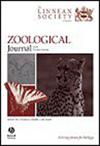A new amphibamiform from the Early Permian of Texas elucidates patterns of cranial diversity among terrestrial amphibamiforms
IF 3
2区 生物学
Q1 ZOOLOGY
引用次数: 0
Abstract
Amphibamiform temnospondyls are at the forefront of discourse surrounding modern amphibian evolutionary origins. Here we present a new amphibamiform, Kermitops gratus gen. et sp. nov., from the Lower Clear Fork Formation of the Early Permian of Texas. Kermitops reveals a mosaic of features shared with other amphibamiforms and possesses unique characteristics, including an internarial fontanelle formed by the premaxillae without contribution of the nasals. It possibly possesses a basioccipital that contributes to the occipital condyle, which has significant implications for recent hypotheses of the evolution of the modern amphibian neurocranium. Parsimony analyses recover non-traditional amphibamiform relationships but place Kermitops within Amphibamiformes. Bayesian inference analysis captures a more traditional hypothesis of amphibamiform relationships; however, the time-calibrated analysis under the fossilized birth–death model recovers a topology that mirrors the parsimony topologies. The low robusticity of topologies across different permutations employing traditional and modern methods suggest a need for improvement of current morphological datasets of lissamphibian origins. A morphometric analysis of the crania of terrestrial amphibamiforms reveals the evolution of disparate cranial morphologies among coeval taxa from the Early Permian of Texas.德克萨斯早二叠世的一种新两栖类阐明了陆生两栖类头骨多样性的模式
围绕现代两栖动物进化起源的讨论中,两栖类天鼻虫处于最前沿。在这里,我们展示了一种新的两栖类--Kermitops gratus gen.Kermitops揭示了与其他两栖类共同的镶嵌特征,并具有独特的特征,包括由前颌骨形成的内部囟门,而没有鼻骨的参与。它可能拥有一个有助于枕骨髁的基枕骨,这对最近关于现代两栖类神经颅骨进化的假说具有重要影响。解析分析恢复了非传统的两栖类关系,但将Kermitops归入两栖类。贝叶斯推理分析捕捉到了一种更为传统的两栖类关系假说;然而,在化石出生-死亡模型下进行的时间校准分析所恢复的拓扑结构与解析拓扑结构一致。采用传统方法和现代方法进行不同排列的拓扑结构的稳健性较低,这表明需要改进目前有关片脚类动物起源的形态学数据集。对陆生两栖类头盖骨的形态计量分析揭示了德克萨斯早二叠世共生类群之间不同头盖骨形态的演化。
本文章由计算机程序翻译,如有差异,请以英文原文为准。
求助全文
约1分钟内获得全文
求助全文
来源期刊
CiteScore
6.50
自引率
10.70%
发文量
116
审稿时长
6-12 weeks
期刊介绍:
The Zoological Journal of the Linnean Society publishes papers on systematic and evolutionary zoology and comparative, functional and other studies where relevant to these areas. Studies of extinct as well as living animals are included. Reviews are also published; these may be invited by the Editorial Board, but uninvited reviews may also be considered. The Zoological Journal also has a wide circulation amongst zoologists and although narrowly specialized papers are not excluded, potential authors should bear that readership in mind.

 求助内容:
求助内容: 应助结果提醒方式:
应助结果提醒方式:


